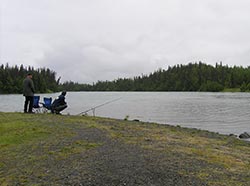Confluence of Moose and Kenai Rivers

Notable Species
- Sockeye salmon
- Trumpeter swan
- Bufflehead
- Common goldeneye
- Barrow’s goldeneye
- Mergansers
- Gulls
- Arctic tern
- Swallows
The confluence of the tea-colored Moose River with the blue-green Kenai River creates a major holding area for thousands of sockeye salmon migrating to spawning grounds in June and July. Watch for rolling and jumping where the currents join. The channel broadens and encompasses wetlands in the first miles upstream from the Sterling Highway bridge, offering a vast staging area for swans, ducks, geese and other migrating birds in the spring. Look for juvenile salmon swimming in shallow water along the shore. During summer, the confluence draws activity by Arctic terns, swallows and gulls. Moose can sometimes be seen in the early morning.
Habitat
The habitat is mixed white spruce and paper birch forest and wetland run along the shore, creating a lush riparian zone alongside a clear-running river and a glacial river. During glacial periods the Kenai River was diverted by ice into the Moose River drainage, creating the wide channel observed today upstream of the bridge.
Viewing Tip
Bring waders or boots to venture out to view salmon. Use a canoe or spotting scope to explore the slow-moving Moose River upstream.
Getting There
Sterling Highway milepost 81.9—turn south to the Izaak Walton State Recreation Site.
Do not paddle in the Kenai River unless you’re prepared for strong currents and cold water.
